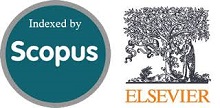An Investigation of Dynamic Soil-Structure Interaction on the Seismic Behavior of RC Base-Isolated Buildings
Abstract
Â
Doi: 10.28991/CEJ-2024-010-11-01
Full Text: PDF
Keywords
References
Naeim, F., & Kelly, J. M. (1999). Design of seismic isolated structures: from theory to practice. John Wiley & Sons, Hoboken, United States. doi:10.1002/9780470172742.
Ziraoui, A., Kissi, B., Aaya, H., & Azdine, I. (2024). Seismic behavior of base-isolated building structures with lead rubber bearings (LRBs). Procedia Structural Integrity, 61, 171–179. doi:10.1016/j.prostr.2024.06.023.
Usta, P. (2021). Investigation of a base-isolator system’s effects on the seismic behavior of a historical structure. Buildings, 11(5), 217. doi:10.3390/buildings11050217.
Kramer, S. L. (1996). Geotechnical Earthquake Engineering. Pearson, London, United Kingdom.
Alavi, E., & Alidoost, M. (2012). Soil-structure interaction effects on seismic behavior of base-isolated buildings. 15th World Conference on Earthquake Engineering (WCEE 2012), 24-28 September 2012, Lisbon, Portugal.
Hatami, F., Nademi, H., & Rahaie, M. (2015). Effects of Soil-Structure Interaction on the Seismic Response of Base Isolated in High-Rise Buildings. International Journal of Structural and Civil Engineering Research, 4(3), 237-242. doi:10.18178/ijscer.4.3.237-242.
Du, D. S., Wang, S. G., Liu, W. Q., Shi, S., Lee, C. P., & Xu, J. (2018). Modal property of base-isolated high-rise structure considering soil–structure interaction effect. Advances in Mechanical Engineering, 10(12), 1687814018803808. doi:10.1177/1687814018803808.
Yanik, A., & Ulus, Y. (2023). Soil–Structure Interaction Consideration for Base Isolated Structures under Earthquake Excitation. Buildings, 13(4). doi:10.3390/buildings13040915.
Forcellini, D. (2018). Seismic assessment of a benchmark based isolated ordinary building with soil structure interaction. Bulletin of Earthquake Engineering, 16(5), 2021–2042. doi:10.1007/s10518-017-0268-6.
Cruz, C., & Miranda, E. (2017). Evaluation of soil-structure interaction effects on the damping ratios of buildings subjected to earthquakes. Soil Dynamics and Earthquake Engineering, 100, 183–195. doi:10.1016/j.soildyn.2017.05.034.
Chopra, A. K. (2014). Dynamics of structures theory and applications to earthquake engineering (4th Ed.). Prentice Hall, Hoboken, United States.
Clough, R. W., & Penzien, J. (2003). Dynamic of Structures. McGraw-Hill, New York, United States.
Lamb, H. (1904). I. On the propagation of tremors over the surface of an elastic solid. Philosophical Transactions of the Royal Society of London. Series A, Containing papers of a mathematical or physical character, 203(359-371), 13. doi:10.1098/rsta.1904.0013.
Poulos, H. G., & Davis, E. H. (1974). Elastic solutions for soil and rock mechanics. John Wiley & Sons, Hoboken, United States.
Hadjian, A. H., Luco, J. E., & Tsai, N. C. (1974). Soil-structure interaction: Continuum or finite element? Nuclear Engineering and Design, 31(2), 151–167. doi:10.1016/0029-5493(75)90138-7.
Wolf, J. P., & Deeks, A. J. (2004). Cones to model foundation vibrations: Incompressible soil and axi-symmetric embedment of arbitrary shape. Soil Dynamics and Earthquake Engineering, 24(12), 963–978. doi:10.1016/j.soildyn.2004.06.016.
Wolf, J. P., & Deeks, A. J. (2004). Foundation vibration analysis: A strength of materials approach. Elsevier, Butterworth-Heinemann, Oxford, United Kingdom.
Wolf, J. P. (1994). Foundation vibration analysis using simple physical models. Pearson Education, London, United Kingdom.
Bapir, B., Abrahamczyk, L., Wichtmann, T., & Prada-Sarmiento, L. F. (2023). Soil-structure interaction: A state-of-the-art review of modeling techniques and studies on seismic response of building structures. Frontiers in Built Environment, 9. doi:10.3389/fbuil.2023.1120351.
Pradhan, P. K., Baidya, D. K., & Ghosh, D. P. (2004). Dynamic response of foundations resting on layered soil by cone model. Soil Dynamics and Earthquake Engineering, 24(6), 425–434. doi:10.1016/j.soildyn.2004.03.001.
Gazetas, G. C., & Roesset, J. M. (1979). Vertical Vibration of Machine Foundations. Journal of the Geotechnical Engineering Division, 105(12), 1435–1454. doi:10.1061/ajgeb6.0000899.
Meek, J. W., & Wolf, J. P. (1993). Why cone models can represent the elastic half-space. Earthquake Engineering & Structural Dynamics, 22(9), 759-771. doi:10.1002/eqe.4290220903.
Bararnia, M., Hassani, N., Ganjavi, B., & Ghodrati Amiri, G. (2018). Estimation of inelastic displacement ratios for soil-structure systems with embedded foundation considering kinematic and inertial interaction effects. Engineering Structures, 159, 252–264. doi:10.1016/j.engstruct.2018.01.002.
Hassani, N., Bararnia, M., & Ghodrati Amiri, G. (2018). Effect of soil-structure interaction on inelastic displacement ratios of degrading structures. Soil Dynamics and Earthquake Engineering, 104, 75–87. doi:10.1016/j.soildyn.2017.10.004.
Lu, Y., Hajirasouliha, I., & Marshall, A. M. (2018). An improved replacement oscillator approach for soil-structure interaction analysis considering soft soils. Engineering Structures, 167, 26–38. doi:10.1016/j.engstruct.2018.04.005.
Ganjavi, B., Gholamrezatabar, A., & Hajirasouliha, I. (2019). Effects of soil-structure interaction and lateral design load pattern on performance-based plastic design of steel moment resisting frames. Structural Design of Tall and Special Buildings, 28(11), e1624. doi:10.1002/tal.1624.
Saito, T. (2024). Structural Earthquake Response Analysis 3D, (STERA 3D Version 11.5). Earthquake Disaster Engineering Research Laboratory, Toyohashi University of Technology, Toyohashi, Japan. Available online: https://rc.ace.tut.ac.jp/saito/software-e.html#p01 (accessed on October 2024).
Ishiyama, Y. (2011). Introduction to Earthquake Engineering and Seismic Codes in the World. Lecture Note, Hokkaido University, Hokkaido, Japan.
The Japan Society of Seismic Isolation (JSSI). (2024). Seismic isolation structures worldwide. The Japan Society of Seismic Isolation (JSSI), Tokyo, Japan.
Pietra, D., Pampanin, S., Mayes, R. L., Wetzel, N. G., & Feng, D. (2015). Design of base-isolated buildings. Bulletin of the New Zealand Society for Earthquake Engineering, 48(2), 118–135. doi:10.5459/bnzsee.48.2.118-135.
Wair, B. R., DeJong, J. T., & Shantz, T. (2012). Guidelines for estimation of shear wave velocity profiles. Pacific Earthquake Engineering Research Center, Berkeley, United States.
JIS G 31122020. (2020). steel bars for concrete reinforcement. Japanese Standards Association (JIS), Tokyo, Japan.
Bridgestone Corporation. (2024). Seismic isolation bearings for buildings. Bridgestone Corporation, Tokyo, Japan. Available online: https://www.bridgestone.com/products/diversified/antiseismic_rubber/ (accessed on October 2024).
Oiles Corporation. (2024). Seismic isolator and vibration control devices. Oiles Corporation, Fujisawa, Japan. Available online: https://www.oiles.co.jp/en/products/damping_isolation/ (accessed on October 2024).
Kawakin Corporation. (2024). Seismic isolation oil damper KYM. Kawakin Corporation, Kawaguchi, Japan. Available online: https://kawakinct.co.jp/en/product/#building (accessed on October 2024).
AIJ. (2011). Simple calculation method for dynamic interaction between building and ground. Architectural Institute of Japan, Tokyo, Japan. (In Japanese).
Shibata, A. (2010). Dynamic analysis of earthquake resistant structures. Tohoku University. Sendai, Japan.
Saito, T. (2024). STERA WAVE technical manual version 1.0. Earthquake Disaster Engineering Research Laboratory, Toyohashi University of Technology, Toyohashi, Japan. Available online: https://rc.ace.tut.ac.jp/saito/software-e.html#p03 (accessed on October 2024).
Takeda, T., Sozen, M. A., & Nielsen, N. N. (1970). Reinforced Concrete Response to Simulated Earthquakes. Journal of the Structural Division, 96(12), 2557–2573. doi:10.1061/jsdeag.0002765.
Papanicolaou, G. C., & Zaoutsos, S. P. (2019). Viscoelastic constitutive modeling of creep and stress relaxation in polymers and polymer matrix composites. Creep and Fatigue in Polymer Matrix Composites, 3–59, Woodhead Publishing, Sawston, United Kingdom. doi:10.1016/b978-0-08-102601-4.00001-1.
Jennings, P. C., & Bielak, J. (1973). Dynamics of building-soil interaction. Bulletin of the Seismological Society of America, 63(1), 9–48. doi:10.1785/bssa0630010009.
Zhuang, H., Fu, J., Yu, X., Chen, S., & Cai, X. (2019). Earthquake responses of a base-isolated structure on a multi-layered soft soil foundation by using shaking table tests. Engineering Structures, 179, 79–91. doi:10.1016/j.engstruct.2018.10.060.
Ismail, S. A., Kaddah, F. K., & Raphael, W. E. (2020). Effect of Number of Stories on the Seismic Soil Structure Interaction Performance of Midrise Frame Structures. IOP Conference Series: Materials Science and Engineering, 809(1), 012011. doi:10.1088/1757-899X/809/1/012011.
DOI: 10.28991/CEJ-2024-010-11-01
Refbacks
- There are currently no refbacks.
Copyright (c) 2024 Alvin Kurniawan Santoso, Taiki Saito

This work is licensed under a Creative Commons Attribution 4.0 International License.






